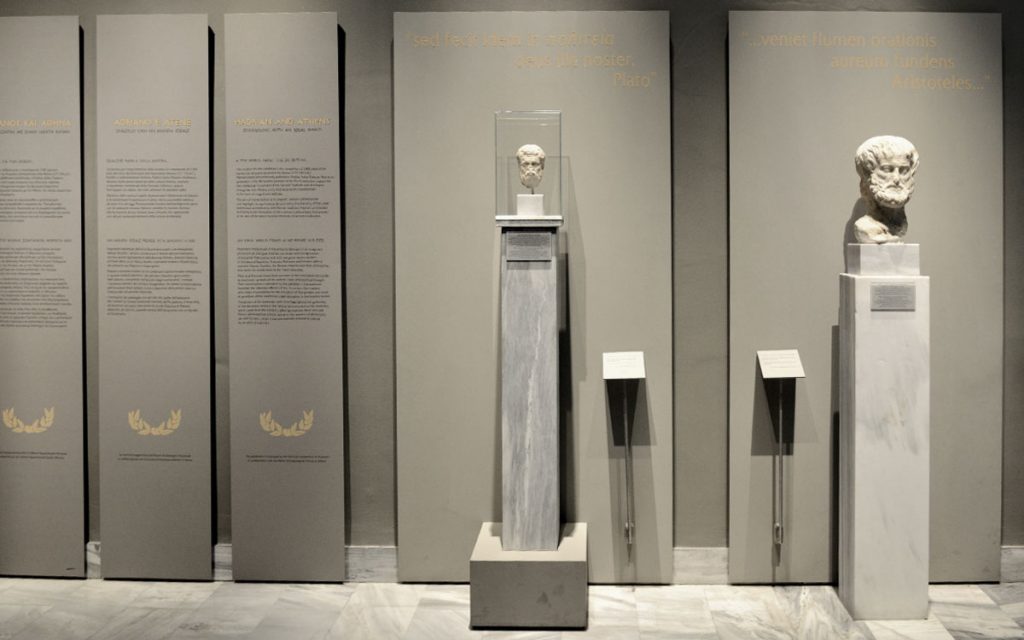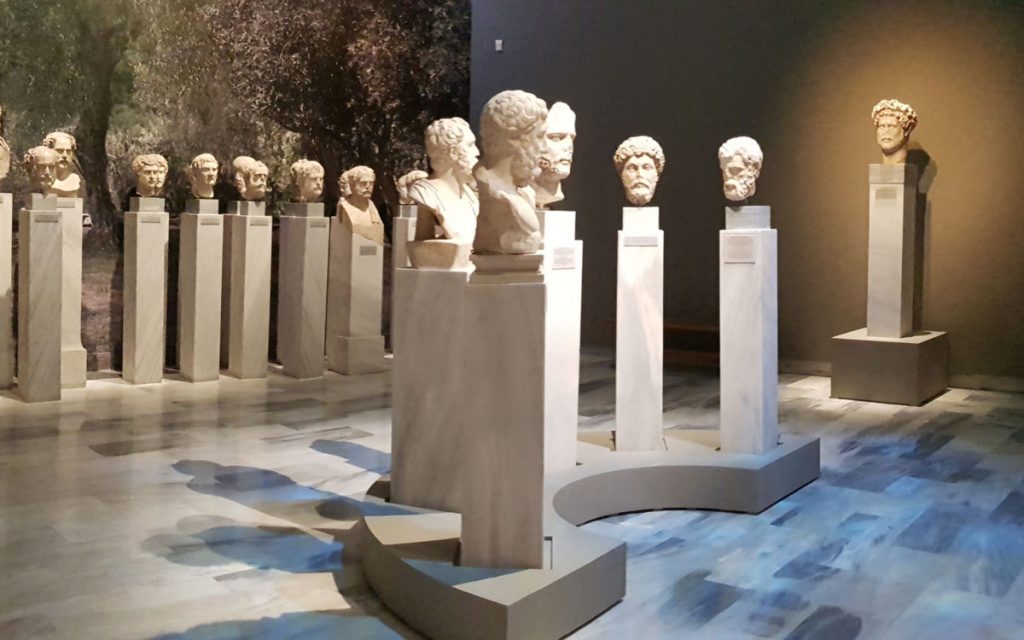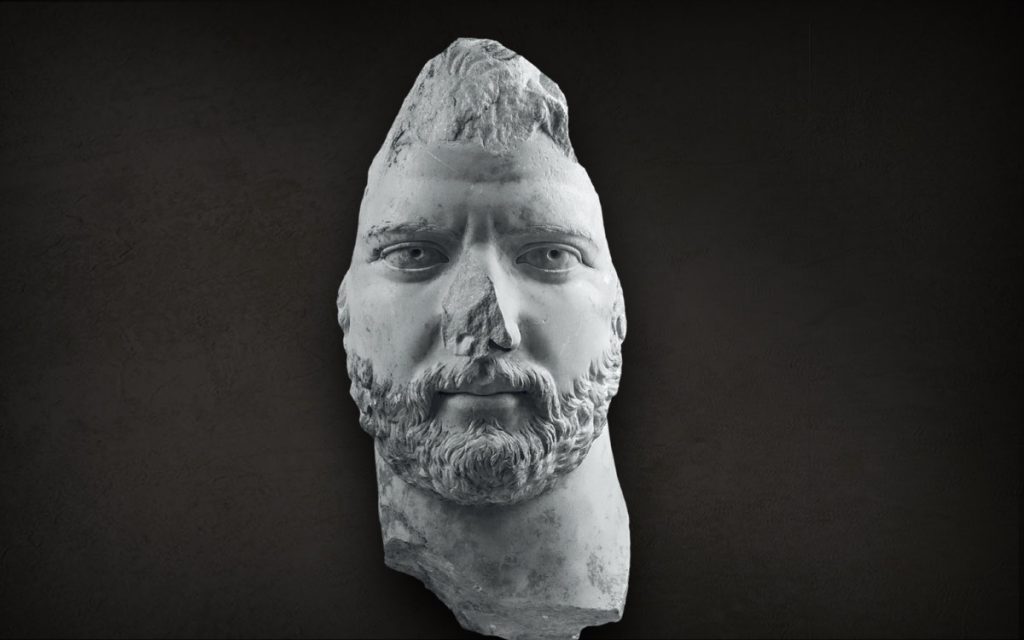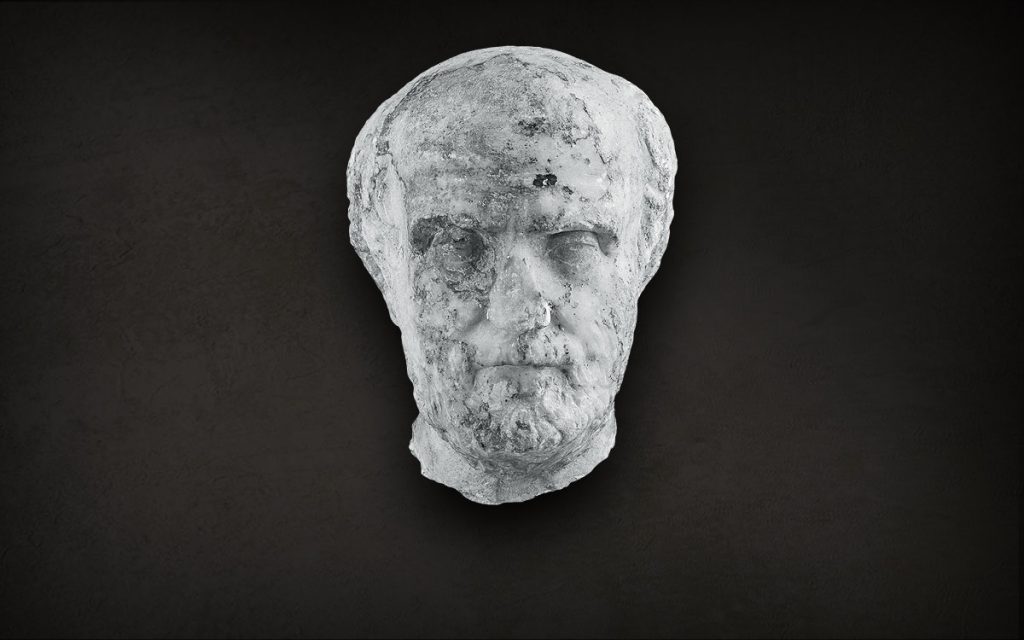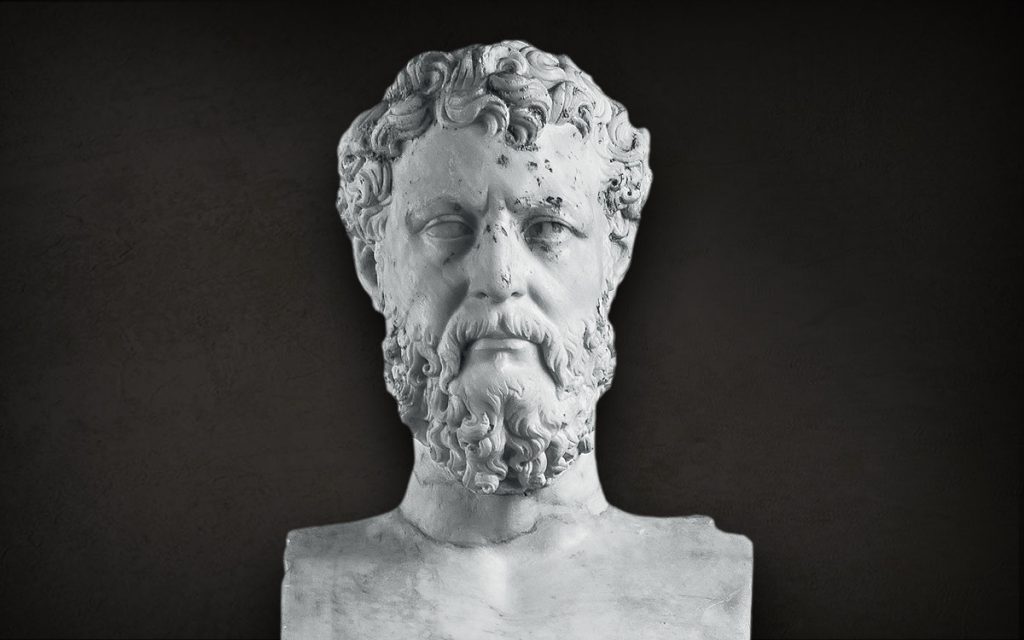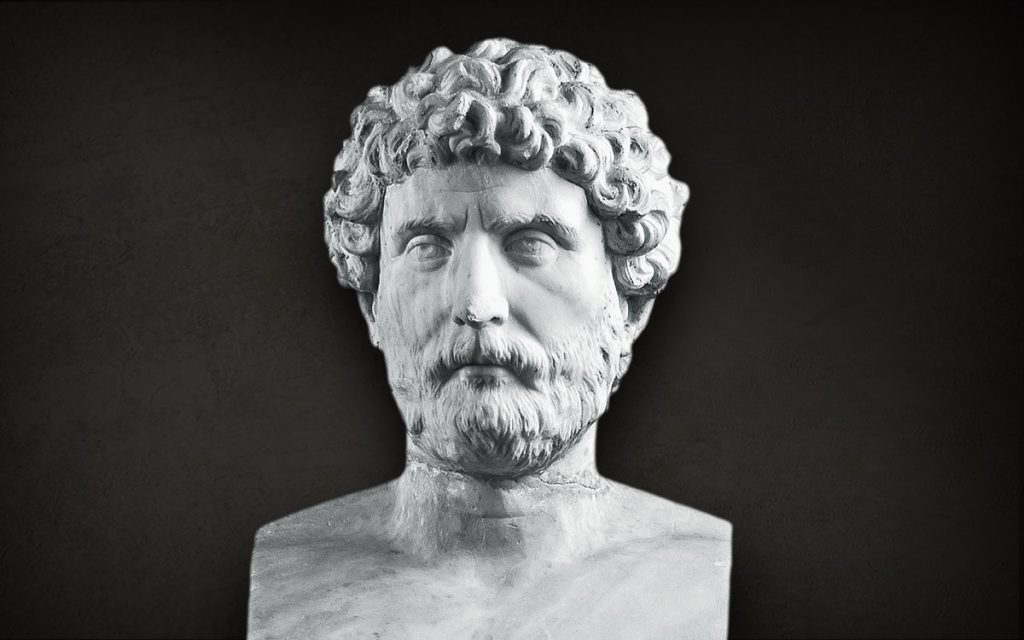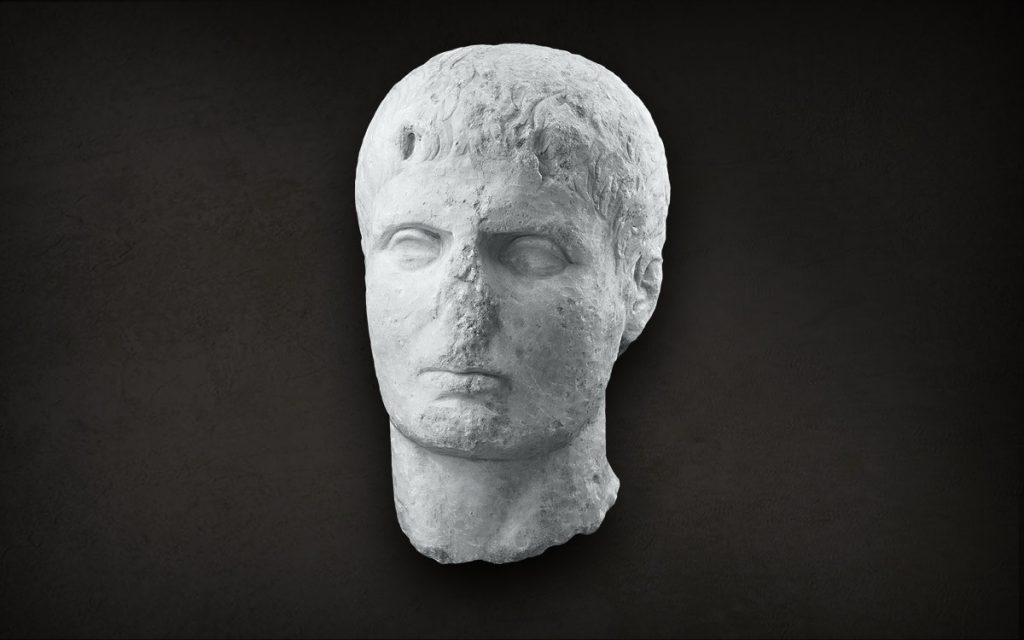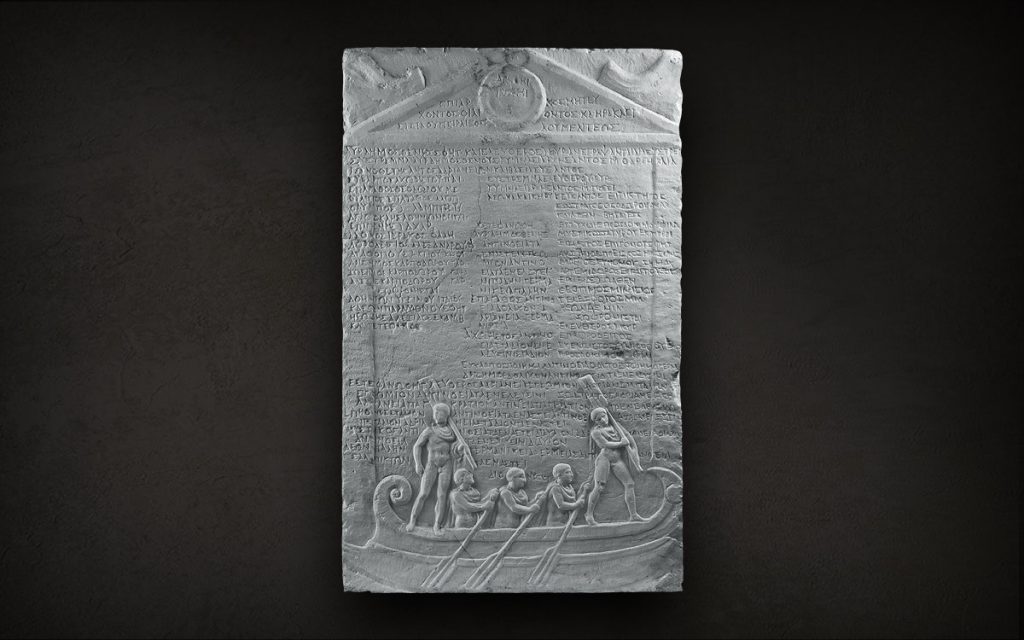Browse digitally the new periodical exhibition of the National Archaeological Museum.
You can browse the Full Screen by tapping the bottom right icon (Small square with dashed lines ![]() ), within the 360VR application.
), within the 360VR application.
In the application, navigate with your cursor to the selected circular viewing points ![]() and see information about the exhibits as well as the digital projections of the exhibition, by clicking on the circular markings.
and see information about the exhibits as well as the digital projections of the exhibition, by clicking on the circular markings.
For those who have 3D navigation glasses (VR Glasses), they can click on the corresponding icon ![]() ,
,
to do virtual tour in 360VR environment.
We wish you good enjoyment of the exhibition!
HADRIAN AND ATHENS
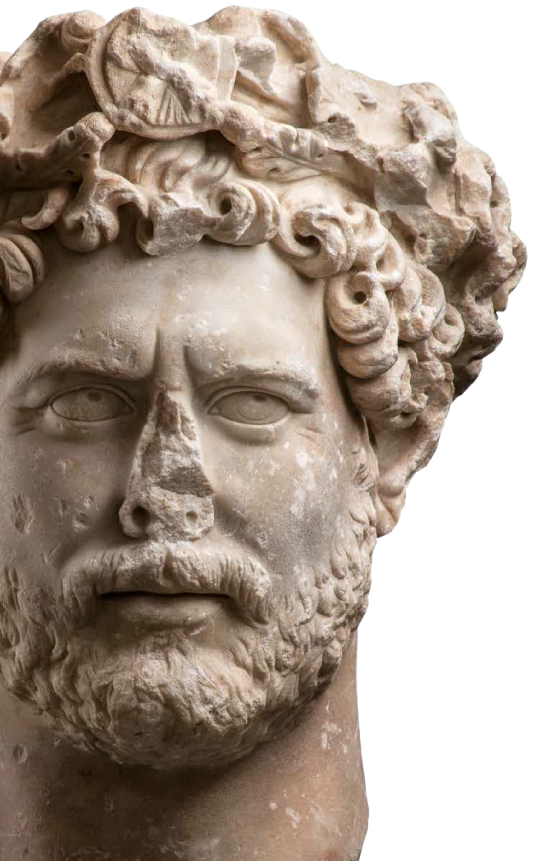
The occasion for the exhibition was the completion of 1.900 years since the Roman emperor ascended the throne (117-138 A.D.). Well-educated and profoundly philhellene, Publius Aelius Traianus Hadrianus, quite early in his life became partaker of the Greek education, supported the intellectual movement of the Second Sophistic and developed strong ties with Athens, a city that received his benefactions in the form of magnificent edifices.
The aim of the exhibition is to present Hadrian’s philhellenism and highlight its significance. By promoting the blending of the Greek intellectual achievements with Roman tradition, Hadrian contributed decisively to the formation of the common cultural basis that proved to be one of the most essential elements of western civilization.

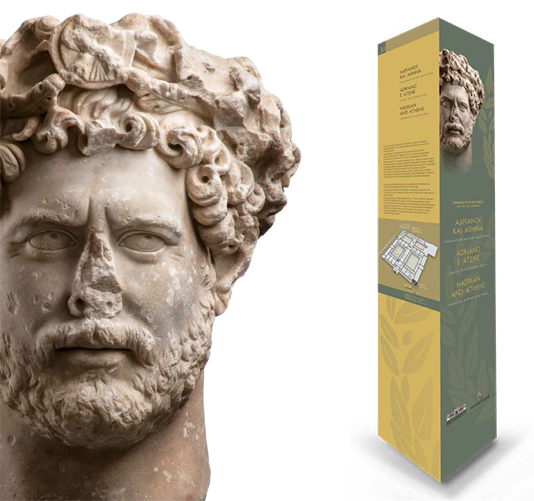

An ideal world comes alive before our eyes
Important intellectuals of the antiquity take part in an imaginary philosophical dialogue. Hadrian converses with the Epicurean philosopher Metrodotus and with two great representatives of the Second Sophistic, Antonius Polemon and Herodes Atticus and with Marcus Aurelius, the Roman emperor and Stoic philosopher, who wrote his meditations in the Greek language.
Plato and Aristotle reveal their presence in this conceptual encounter, as diachronic symbols of the ancient Greek philosophical thought. Their conversation is attended by the gathered in the audience kosmetai, the Athenian officials of the Diogeneion Gymnasium, who retain responsibility for the education of the ephebes and stand as guardians of the traditional Greek education in the Imperial period.
The picture of the landscape with olive trees behind the gathering of the kosmetai enlivens the natural environment of the Academy, where apart from the similarly called Gymnasium, there also was Plato’s philosophical school, active in the matters of philosophy up until 529 A.D., when it was permanently reduced to silence by an edict of Justinian.
Plato and Aristotle
Diachronic symbols of the Greek philosophical thought
Provenance: Athens. Height: 0.18 m. Marble: pentelic.
Chronology: Roman copy of an original dating about 360 BC.
EAM 3735
The figure is depicted with wrinkles on the forehead and knitted eyebrows suggesting thoughtfulness. The original portrait probably derives from the head of a renowned statue, carved by the Athenian sculptor Silanion. The statue was erected in the Gymnasium of Academy, where the great philosopher, who brought the Athenian philosophy to its peak, taught.
Plato and Aristotle
Diachronic symbols of the Greek philosophical thought
Provenance: Athens. Height: 0.42 m. Marble: pentelic.
Chronology: Roman copy of an original dating from the last quarter of the 4th century BC.
EAM 3772
Aristotle studied at the Academy of Plato and in 335 B.C. he founded his own school in the Gymnasium of the Lykeion. Along with philosophy, he dealt with the scientific research and is thus considered the founder of many sciences. His teaching aimed at the approach of all fields of knowledge, so that the individual would be able to develop a multifaceted personality, which was accomplished by the parallel training of the body.
Plato and Aristotle
Diachronic symbols of the Greek philosophical thought
Provenance: Athens. Height: 0.42 m. Marble: pentelic.
Chronology: Roman copy of an original dating from the last quarter of the 4th century BC.
EAM 3772
Aristotle studied at the Academy of Plato and in 335 BC. he founded his own school in the Gymnasium of the Lykeion. Along with philosophy, he dealt with the scientific research and is thus considered the founder of many sciences. His teaching aimed at the approach of all fields of knowledge, so that the individual would be able to develop a multifaceted personality, which was accomplished by the parallel training of the body.
A symbolic dialogue
Portrait of Hadrian
Chronology: 130-140 AD. EAM 3729
The figure wears a corona civica (wreath) of oak leaves, to which golden leaves were once attached. The oak and the eagle on the wreath of the philhellene emperor are characteristic symbols of Zeus and probably refer to the title of Olympios, which was given to Hadrian in AD 128 in Athens, along with the completion of the temple of the Olympian Zeus in AD 131/132.
The head was intended to be inserted into a colossal, probably cuirassed, statue. The portrait, a major work of an attic workshop, is considered to be a free rendering of the «Imperatori 32» type. The depiction of Hadrian with a luxuriant hairstyle and a beard signifies a shift towards Greek models of the classical period.
Portrait of Hadrian
Chronology: 130-140 AD. EAM 632
The head is turned slightly to the left and was intended for insertion, as it is shown by the treatment of the surface. The figure would have worn a himation. A work of a Greek artistic sense created by a distinguished artist. The portrait belongs to the «Imperatori 32» type.
The shift towards the education and the culture of Classical Greece, introduced programmatically by Hadrian, resulted in the imitation of the Greek way of dressing and of the hair style.
Bust of the Epicurean philosopher Metrodoros
Chronology: 117-138 AD. EAM 368
Metrodoros is depicted bearded. He turns the head to the left and wears a himation over his left shoulder. On his chin, the luxuriant beard is divided into two parts. The smooth forehead with the soft wrinkles, the broad cheeks, the pronounced cheekbones, the straight, classical nose and the fleshy, partly open lips evoke models of the 4th century BC.
Bust of the sophist Polemon (?)
Chronology: 130-140 AD. EAM 427
The portrait depicts a bearded man. He turns the head sharply upwards and to the left and he wears a himation over his shoulders. The crescent-shaped locks form a tongue-shaped extension on the forehead. The eyelids, rendered in «metallic» precision, the expression wrinkles and the partly open mouth evoke Classical models. It has been suggested that the portrait represents the sophist Polemon, famed for his haughty and pompous style.
Portrait of Herodes Atticus
Chronology: around 150 AD. EAM 435
The portrait depicts Vibullius Hipparchus Tiberius Claudius Atticus Herodes (101-178 AD), a prominent Athenian orator and sophist philosopher, who was a benefactor principally of Athens, but also of many other cities, by erecting public buildings. In the context of the Second Sophistic, Herodes had Hadrian, who was one of his numerous pupils, as a model in his public and personal life (imitatio Hadriani).
Portrait of Marcus Aurelius
Chronology: after 170 AD. EAM 572
Marcus Aurelius is depicted in the third type of his iconography. The hair is rendered in dense flammiform locks, while the luxuriant beard forms spiral locks worked in lower relief. The high forehead, the heavy eyelids, the flat, smooth cheeks and the partly open mouth evoke Classical models. The calmness and the self-control in the expression are due to the stoic philosophy, of which he was an adheren.
The gymnasia
Places of corporal and spiritual instruction of youths
Gymnasia are since the 6th century B.C. the places par excellence for the athletic training of youths. From the 5th century B.C. physical exercise is combined with spiritual instruction, primarily aiming at the harmonious integration of young people into the socio-political and religious life of the city. In Roman times, gymnasium education focuses on the cultivation of the spirit, while physical exercise is limited. Already in the mid 2nd century B.C. the education programme includes classes on oratory, philosophy, but also on other sciences, such as medicine, physics and astronomy, resulting in the transformation of the gymnasia into educational institutions, with teaching rooms, lecture halls, even libraries. Philosophers and orators find at the gymnasia their audience and their natural abode. The three traditional gymnasia of ancient Athens, Academy, Lyceum, Cynosarges, were situated in groves outside the city walls. Towards the end of the 3rd or the beginning of the 2nd century B.C., two other gymnasia, the Diogeneion and the Ptolemaion, are founded in the heart of the ancient city.
Bust of Antinous
Chronology: just after 130 AD. EAM 417
Nude bust with the head in the main figural type of Antinous, Hadrian’s beloved. The type was probably the creation of an attic workshop and was especially popular. Full nudity suggests the hero worship [of Antinous] and the association with the gymnasium, through which the veneration of Antinous was promoted.
Attic red-figure kylix atributed to the London Painter D12
Chronology: around 465-455 BC. EAM A 12462
The two sides of the exterior depict a school scene. The column behind the seated student suggests the interior space of the school. The young man is about to receive from his teacher, the grammatistes, a diptych, namely, a tablet for writing exercises. Correspondingly, on the other side, a young man, prepares to receive his lyre from the music teacher for the class of music.
Attic red-figure kylix attributed to Lyandros Painter
Chronology: around 460 BC. EAM A 17302
Both sides of the exterior depict scenes from the athletic activity in the palaestra, the stoic building of which is indicated by a column. In the centre of one side, an athlete with a stleggis looks at his co-athlete, who is preparing to throw the javelin. On the right, a young man in himation, perhaps the paidotribes, supervises both athletes. On the other side, an athlete offers an aryballos with perfumed oil to another one undresses in order to compete. Another paidotribes in himation supervises both athletes.
Stele of a «kosmetes» and of ephebes
Chronology: 117-138 AD. EAM 1468
On a projecting base stand three relief male figures. In the centre, the «kosmetes» is crowned by an ephebe wearing a chlamys. On his right, is shown another ephebe, nude, crowning himself and holding a palm branch; next to him rests a hydria. The background of the representation would have been red initially. At the bottom, a ship with seven oarsmen and a helmsman refers to a «naval battle» contest. The inscription on the shaft of the stele may have been painted.
Stele with catalogue of ephebes under the kosmetes Archelaos
Chronology: 139-140 AD. EAM 1484
The stele is divided into two unequal parts. On the cornice, is the inscription: «For the Good Fortune of the Emperor Antoninus» (Agathei Tychei Autokratoros Antoneinou). At the top, are depicted three male figures in relief. In the centre, the kosmetes Archelaos, son of Apollonios, from Piraeus, wrapped in his himation, is crowned by two ephebes, one wearing a himation and the other a chlamys. The inscription on the field mentions the archon, the sophronistai, the paidotribes, the hoplomachos and the hegemon. At the bottom, are inscribed names of ephebes, citizens of Athens (protengraphoi) and foreigners (epengraphoi).
Stele with catalogue of ephebes under the kosmetes Herakleides
Chronology: 163/164 AD. ΕAΜ 1466
The stele is crowned by a relief pediment inscribed in the rectangular slab. The inscription mentions the name of the archon and the kosmetes Herakleides from Melite. On the shaft of the stele are inscribed names of ephebes (Athenians and foreigners), festivals (Antinoeia in the City and in Eleusis, Germanikeia, Hadrianeia), the two systremmatarchai and other officials of the gymnasium (agonothetai, gymnasiarchoi, sophronistai). At the bottom is the depiction of a ship with three seated oarsmen, wearing a chlamys, and two others, standing at the prow and at the stern, with the oars over their shoulders.
Stele with catalogue of ephebes under the kosmetai Aur. Dositheos and Thales son of Dositheos
Chronology: 212/213 AD or later. EAM 1465
The stele is divided into two unequal parts. At the top, inside a rectangular recessed panel, are depicted three relief male figures. In the centre, the kosmetes Aur. Dositheos or Thales, son of Dositheos, wrapped in his himation, is crowned by two ephebes, one wearing a himation and the other a chlamys, who hold palm branches. Next to the kosmetes, is depicted a bundle of scrolls, while an amphora rests next to the ephebe on the right. To the left and right of the panel are relief olive wreaths with inscriptions indicating that the kosmetes honour the ephebes and the ephebes honour the kosmetes. Under the panel are inscribed names of the officials and instructors of the Gymnasium (antikosmetes, paidotribes, grammateus, sophronistai, hyposophronistai, prostates, hypopaideotribes, hegemon, hoplomachos, didaskalos, hypogrammateus, kestrophylax, gymnasiarchoi, systremmatarchai, strategoi, kerykes, basileus, polemarchos, agoranomoi, astynomoi), festivals (Antinoeia, Germanikeia, Antoneia, Hadrianeia, Theseia, Athenaia, Severeia, Amphiareia) and ephebes by tribe. At the bottom, two relief ships, each manned by two oarsmen, refer to the «naval battle» contest in which the sons of the kosmetes had taken part.
The exhibition was organized by the National Archaeological Museum in collaboration with the Italian Archaeological School of Athens. It is being presented in room 31a of Roman Sculptures since 28.11.2017.
